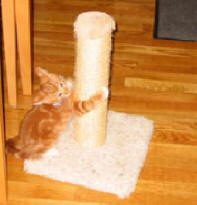Introduction
 One
purpose of feline clawing is
to sharpen claws. This is where
the cat actually removes old
claw fragments due to new claw
growth. It is more like the
shedding of a snake's
skin than the sharpening of
a kitchen knife.
One
purpose of feline clawing is
to sharpen claws. This is where
the cat actually removes old
claw fragments due to new claw
growth. It is more like the
shedding of a snake's
skin than the sharpening of
a kitchen knife.
 Feline
clawing is also a visual mark
of territory since another cat
can see a clawed mark even if
the smell has gone. It is also
an olfactory mark of territory
because of scent producing glands
in the paws.
Feline
clawing is also a visual mark
of territory since another cat
can see a clawed mark even if
the smell has gone. It is also
an olfactory mark of territory
because of scent producing glands
in the paws.
 Another
reason for clawing is to exercise
or stretch while clawing. If
problem clawing seems associated
with exercise, begin daily play
sessions. Including string chasing,
and provide an area to climb
before the destructive clawing
can take place.
Another
reason for clawing is to exercise
or stretch while clawing. If
problem clawing seems associated
with exercise, begin daily play
sessions. Including string chasing,
and provide an area to climb
before the destructive clawing
can take place.
How To Respond To Destructive
Clawing In The Home
Make
the old scratch location less
desirable:
-
Spray with scent repellent
from the pet store
-
Temporarily apply plastic
wrap or aluminum foil to the
clawed area.
-
Use a water sprayer or shake
can when cat is observed in
the act.
-
Throw a small pillow or magazine
to frighten and make the area
unpredictable.
-
Don't punish personally since
it may cause anxiety, and
decrease your bonding.
 Place
a plastic runner with
small spikes on the bottom upside
down on the floor
where the cat stands during
destructive clawing. Place
a plastic runner with
small spikes on the bottom upside
down on the floor
where the cat stands during
destructive clawing. |
Make
the new preferred location more
desirable:
 Place
multiple posts of different
sizes and types. Place a scratching
post close by where there is
no runner, and next to the previously
scratched location. Make sure
the material is as close as
possible to that of the chair.
(e.g. wood vs. carpet vs. other
fabric) If practical, temporarily
remove the chair (or cover it
in plastic) so only the post
is available at that location.
Place
multiple posts of different
sizes and types. Place a scratching
post close by where there is
no runner, and next to the previously
scratched location. Make sure
the material is as close as
possible to that of the chair.
(e.g. wood vs. carpet vs. other
fabric) If practical, temporarily
remove the chair (or cover it
in plastic) so only the post
is available at that location.
Make
the scratching post as desirable
as possible:
-
If the cat likes catnip, apply
a liberal amount on the top
and sides of the post.
-
If the cat likes a particular
person, rub a sweaty shirt
on the post.
- Move
the cat's claws over
the post surface and praise
it.
-
Put the cat on the post, and
praise it when in contact.
(Otherwise ignore.)
-
Put a favorite toy on top
to encourage climbing with
claws.
-
Watch the cat when awakening
as this is the
most common clawing time.
- If
it approaches the wrong location,
move it to the desired post
and praise and pet.
-
Cats tend to like a vertically
oriented weave since it cleans
the claws best.
-
Consider multiple posts with
different scratching materials
(rope, bark, wood, etc.)
Other
Techniques:
 Try
isolating the cat temporarily
in a non-carpeted room with
the carpeted post. Observe to
see if the post is used. If
so, begin allowing free access
to the entire house for gradually
increasing periods of time.
If accidents happen, go back
to smaller access and increase
as correct clawing occurs.
Try
isolating the cat temporarily
in a non-carpeted room with
the carpeted post. Observe to
see if the post is used. If
so, begin allowing free access
to the entire house for gradually
increasing periods of time.
If accidents happen, go back
to smaller access and increase
as correct clawing occurs.
The
longer the problem has gone
on, the more difficult to correct,
so a quick response is needed.
It is perfectly fine to clip
the cats nails every few weeks.
It may not reduce the clawing,
but it will reduce the damage
done.
There
is a product called, "Soft
Claws" is a bead glued
onto the claws. One consideration
is that this product needs to
be replaced periodically. The
product typically falls off
with the old nail shell.
Here
are some tips to look for when
selecting a scratching post:
Choose a post 3 feet or higher
for stretching
-
Choose a stable post so it
won't fall over on the
cat.
- Choose
a material that is as similar
as possible to the current
target
-
Choose a material that the
cat can dig its claws into
to remove the outer dead shell
-
Cats tend to like a vertically
oriented weave since it cleans
the claws best.
-
Choose at least one post with
a resting spot on top
-
Consider a tall or floor to
ceiling post that the cat
can climb on for exercise
Remember,
if all else fails you still
have other options:
 Consider
finding a new home for the cat
where it is safe to be outdoors
Consider
finding a new home for the cat
where it is safe to be outdoors
 Consider
the declaw operation.
Consider
the declaw operation.
 Consider
making the cat an "outdoor"
cat.
Consider
making the cat an "outdoor"
cat.